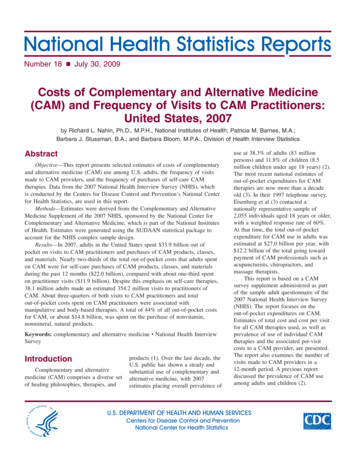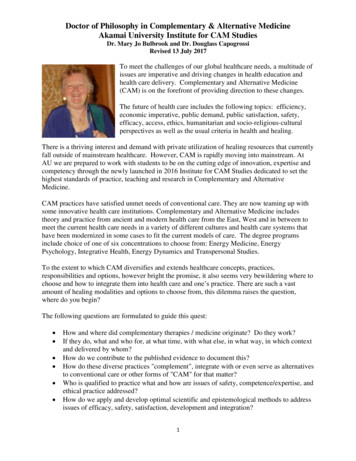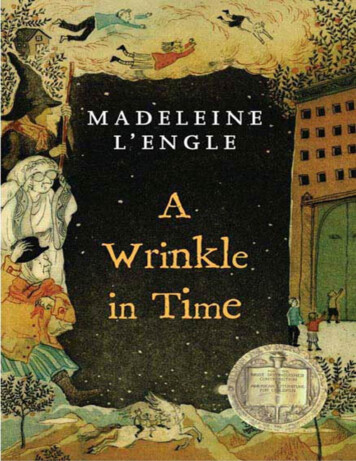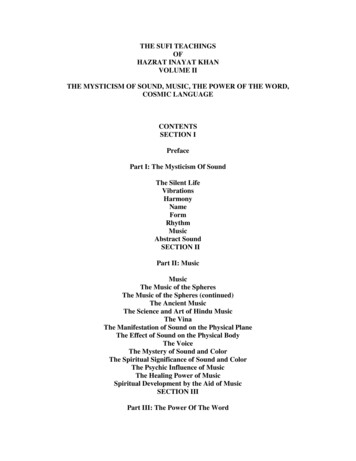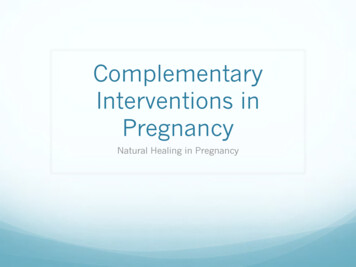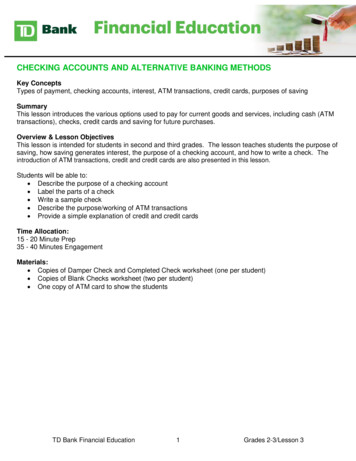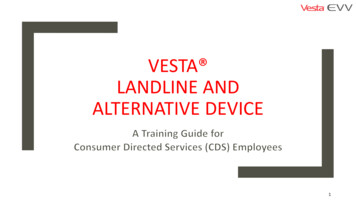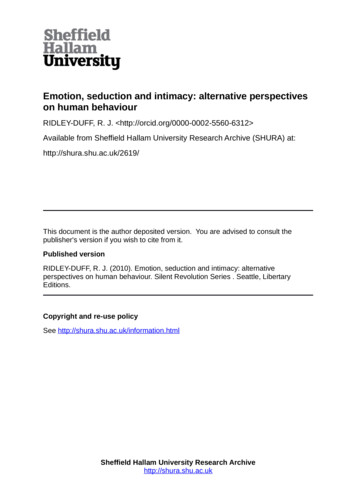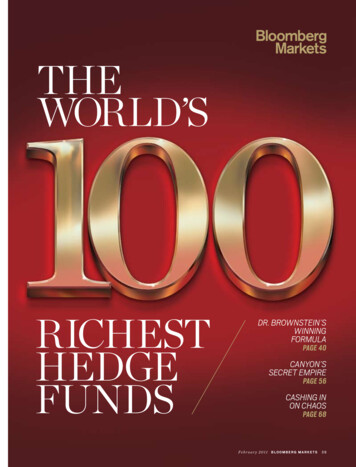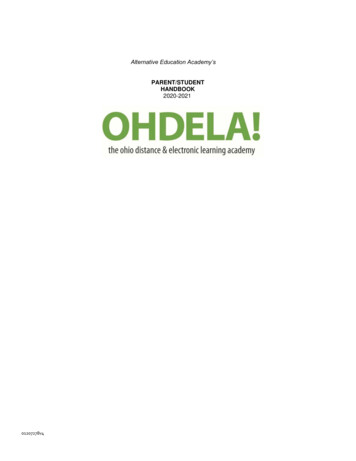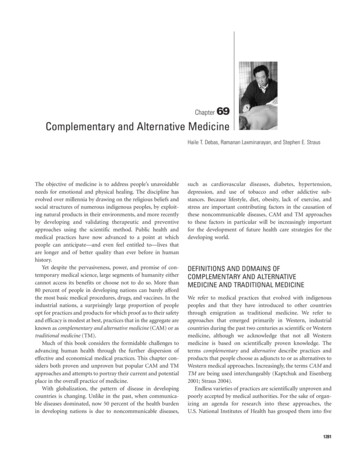
Transcription
Chapter 69Complementary and Alternative MedicineHaile T. Debas, Ramanan Laxminarayan, and Stephen E. StrausThe objective of medicine is to address people’s unavoidableneeds for emotional and physical healing. The discipline hasevolved over millennia by drawing on the religious beliefs andsocial structures of numerous indigenous peoples, by exploiting natural products in their environments, and more recentlyby developing and validating therapeutic and preventiveapproaches using the scientific method. Public health andmedical practices have now advanced to a point at whichpeople can anticipate—and even feel entitled to—lives thatare longer and of better quality than ever before in humanhistory.Yet despite the pervasiveness, power, and promise of contemporary medical science, large segments of humanity eithercannot access its benefits or choose not to do so. More than80 percent of people in developing nations can barely affordthe most basic medical procedures, drugs, and vaccines. In theindustrial nations, a surprisingly large proportion of peopleopt for practices and products for which proof as to their safetyand efficacy is modest at best, practices that in the aggregate areknown as complementary and alternative medicine (CAM) or astraditional medicine (TM).Much of this book considers the formidable challenges toadvancing human health through the further dispersion ofeffective and economical medical practices. This chapter considers both proven and unproven but popular CAM and TMapproaches and attempts to portray their current and potentialplace in the overall practice of medicine.With globalization, the pattern of disease in developingcountries is changing. Unlike in the past, when communicable diseases dominated, now 50 percent of the health burdenin developing nations is due to noncommunicable diseases,such as cardiovascular diseases, diabetes, hypertension,depression, and use of tobacco and other addictive substances. Because lifestyle, diet, obesity, lack of exercise, andstress are important contributing factors in the causation ofthese noncommunicable diseases, CAM and TM approachesto these factors in particular will be increasingly importantfor the development of future health care strategies for thedeveloping world.DEFINITIONS AND DOMAINS OFCOMPLEMENTARY AND ALTERNATIVEMEDICINE AND TRADITIONAL MEDICINEWe refer to medical practices that evolved with indigenouspeoples and that they have introduced to other countriesthrough emigration as traditional medicine. We refer toapproaches that emerged primarily in Western, industrialcountries during the past two centuries as scientific or Westernmedicine, although we acknowledge that not all Westernmedicine is based on scientifically proven knowledge. Theterms complementary and alternative describe practices andproducts that people choose as adjuncts to or as alternatives toWestern medical approaches. Increasingly, the terms CAM andTM are being used interchangeably (Kaptchuk and Eisenberg2001; Straus 2004).Endless varieties of practices are scientifically unproven andpoorly accepted by medical authorities. For the sake of organizing an agenda for research into these approaches, theU.S. National Institutes of Health has grouped them into five1281
somewhat overlapping domains (http://nccam.nih.gov/health/whatiscam) as follows: Biologically based practices. These include use of a vast arrayof vitamins and mineral supplements, natural products suchas chondroitin sulfate, which is derived from bovine or sharkcartilage; herbals, such as ginkgo biloba and echinacea;and unconventional diets, such as the low-carbohydrateapproach to weight loss espoused by the late Robert Atkins. Manipulative and body-based approaches. These kinds ofapproaches, which include massage, have been usedthroughout history. In the 19th century, additional formalmanipulative disciplines emerged in the United States: chiropractic medicine and osteopathic medicine. Both originated in an attempt to relieve structural forces on vertebraeand spinal nerve roots that practitioners perceived as evoking a panoply of illnesses beyond mere musculoskeletal pain. Mind-body medicine. Many ancient cultures assumed thatthe mind exerts powerful influences on bodily functions andvice versa. Attempts to reassert proper harmony betweenthese bodily systems led to the development of mind-bodymedicine, an array of approaches that incorporate spiritual,meditative, and relaxation techniques. Alternative medical systems. Whereas the ancient Greekspostulated that health requires a balance of vital humors,Asian cultures considered that health depends on the balance and flow of vital energies through the body. This lattertheory underlies the practice of acupuncture, for example,which asserts that vital energy flow can be restored byplacing needles at critical body points. Energy medicine. This approach uses therapies that involvethe use of energy—either biofield- or bioelectromagneticbased interventions. An example of the former is Reiki therapy, which aims to realign and strengthen healthful energiesthrough the intervention of energies radiating from the handsof a master healer.Alternative systems of medicine use elements from each ofthese CAM and TM domains. For example, traditional Chinesemedicine incorporates acupuncture, herbal medicines, specialdiets, and meditative exercises such as tai chi. Ayurveda in Indiasimilarly uses the meditative exercises of yoga, purifying diets,and natural products. In the West, homeopathic medicine andnaturopathic medicine each arose in the late 19th century asreactions to the largely ineffectual and toxic conventionalapproaches of the day: purging, bleeding, and treatments withheavy metals such as mercury and arsenicals.DEMOGRAPHY, USE, TOXICITY, AND EFFICACYThe use of CAM and TM varies widely between and within countries. The World Health Organization (WHO) has published andTable 69.1 Estimated Use of CAM and TM by Patients andPractitioners WorldwideRegion or countryExtent of useAfricaUsed by 80 percent of the population for primaryhealth careAustraliaUsed by 49 percent of adultsChinaAccounts for 30 to 50 percent of total health careFully integrated into the health system95 percent of Chinese hospitals have TM unitsIndiaWidely usedIndonesiaUsed by 40 percent of the entire population2,860 hospitals provide TMUsed by 70 percent of the rural populationJapan72 percent of physicians practice TMThailandTM integrated into 1,120 health centersVietnamFully integrated into the health care systemWestern countriesCAM and TM not strongly integrated into the healthcare system30 percent of the population is treated with TMFrance: at least 75 percent of the population has usedCAM at least onceGermany: 77 percent of pain clinics provide acupunctureUnited States: 29 to 42 percent of population usesCAMSource: WHO 2002.summarized numerous surveys of use (table 69.1). In developingnations, TM is the sole source of health care for all but the privileged few. By contrast, in affluent countries individuals selectCAM approaches according to their specific beliefs. For example,as many as 60 percent of those living in France, Germany, and theUnited Kingdom consume homeopathic or herbal products.Only 1 to 2 percent of Americans use homeopathy,but 10 percentof adults use herbal medicines, 8 percent visit chiropractors, and1 to 2 percent undergo acupuncture every year (Ni, Simile, andHardy 2002). Use of CAM and TM among patients with chronic, painful, debilitating, or fatal conditions, such as HIV/AIDSand cancer, is far higher, ranging from 50 to 90 percent(Richardson and Straus 2002).There is remarkably little correlation between the use ofCAM and TM approaches and scientific evidence that they aresafe or effective. For many CAM and TM practices, the onlyevidence of their safety and efficacy is embodied in folklore.Beginning more than 1,500 years ago, data on the use ofthousands of natural products were assembled into impressivemonographs in China, India, and Korea, but these compendiums—and similar texts from Arabic, Egyptian, Greek, andPersian sources and their major European derivatives—aremerely catalogs of products and their use rather than formalanalyses of safety and efficacy.1282 Disease Control Priorities in Developing Countries Haile T. Debas, Ramanan Laxminarayan, and Stephen E. Straus
Table 69.2 Some Natural Products That May Alter DrugActionsHerbal productClass of drugEphedra (ma huang)Alpha and beta adrenergicsGarlicAnticoagulants; some HIV protease inhibitorsGinkgo biloba extractAnticoagulantsGlucosamineAntidiabeticsSaw palmettoAndrogensSt. John’s wortHIV protease inhibitors; some chemotherapydrugs; cyclosporine A; birth controlValerianSedativesSource: Niggemann and Gruber 2003.Many people who today choose herbal products in lieu ofprescription medications assume that because these productsare natural, they must be safe, even when the evidence for thisassertion is essentially anecdotal. Recent studies have shownthat herbals are highly variable in quality and composition,with many marketed products containing little of the intendedingredients and containing unintended contaminants, such asheavy metals and prescription drugs. A few herbals are bannedoutright in several countries. Comfrey and kava have beenassociated with liver failure, aristolochia with genitourinarycancer (De Smet 2002), and ephedra with heart attacks andstrokes (Shekelle and others 2003). More important, herbalscontain ingredients that can accelerate or inhibit the metabolism of prescription drugs (table 69.2). The most notorious ofthese is St. John’s wort, which affects the metabolism of nearly50 percent of all prescription drugs (Markowitz and others2003). The cumulative data on the pharmacological and potential adverse effects of herbal supplements now dictate thatpatients discuss their use of supplements with knowledgeablepractitioners before initiating treatment.As to evidence of the efficacy of CAM and TM approaches,thousands of small studies and case series have been reportedover the past 50 years. Few were rigorous enough to be at allcompelling, but they are sufficient to generate hypotheses thatare now being tested in robust clinical trials. The existing bodyof data already shows that some approaches are useless, that formany the evidence is positive but weak, and that a few arehighly encouraging (table 69.3).ECONOMICS OF COMPLEMENTARY ANDALTERNATIVE MEDICINE AND TRADITIONALMEDICINEAlthough social, medical, and cultural reasons may account forwhy people in a given country prefer CAM and TM to conventional (Western) medicine, economic forces are also at play.This section describes the socioeconomic determinants ofseeking treatment from traditional healers and providers ofCAM; reviews the evidence on the cost-effectiveness of CAMand TM; and discusses cost-effective approaches to regulating,improving, and expanding the use of CAM and TM. Much ofthis evidence is from industrial countries; few studies have beenconducted in or are applicable to low- and middle-incomecountries. This caveat is important for two reasons. First, theCAM and TM modalities discussed in this section may not beused in many developing countries. Second, the limited data oncost-effectiveness may not be applicable in the case of thosecountries. Nevertheless, the data give a rough picture of the relative cost-effectiveness of a number of CAM and TM practices.Economic Factors That Influence the Use of Complementaryand Alternative Medicine and Traditional MedicineUsers of CAM and TM approaches choose health practices thatresonate with their beliefs about health (Astin 1998). Althougheconomic factors play a role in this choice, the underlyingincentives are not always predictable. For instance, a commonmisconception is that patients opt for CAM and TM servicesbecause they are cheaper alternatives to conventional medicalcare. Even though there are certainly instances when the cost oftreatment using CAM or TM is much cheaper than the cost ofaccessing a conventional medical service, several studies havefound that CAM and TM cost the same or more than conventional treatments for the same conditions (see, for example,Muela, Mushi, and Ribera 2000).At least one study has shown that financial considerationsare rarely the primary factor in choosing a traditional healer,ranking behind such reasons as confidence in the treatment,ease of access, and convenience (Winston and Patel 1995). Inthe United States, the average cost of a single visit to a Navajohealer was US 388, and the average annual cost of using atraditional healer represented roughly a fifth of the reportedannual income of respondents in a survey (Kim and Kwok1998). The high cost of using a healer was cited as the mostcommon barrier to seeking care from this source. In Kenya, theaverage charge per patient per visit to a TM practitioner wasK Sh 46 (US 4 in 1981), which was significantly greater thanthe average charge per visit even in private health care facilities(Mwabu, Ainsworth and Nyamete 1993). Finally, a survey inZimbabwe reported that the median cost of consulting anherbalist was Z 23 per visit, compared with Z 1 for a government clinic and Z 29 for a private doctor (Winston and Patel1995). The same survey found that outcomes tended to be better when patients went to government clinics (67.3 percent ofvisits resulted in a good outcome) than when patients consultedherbalists (50 percent of visits resulted in a good outcome).TM is not always more expensive than conventional medicine, however. Survey respondents in Ghana reported that theComplementary and Alternative Medicine 1283
Table 69.3 Levels of Evidence for the Efficacy of Selected CAM and TM ApproachesCAM or TMapproachPotential useStudyoutcomeLevel ofevidenceArtemisia annuaTreating drug-resistant malariaPositiveAvan Agtmael, Eggelte, and van Boxtel 1999Black cohoshControlling menopausal symptomsMixedBKronenberg and Fugh-Berman 2003CranberryPreventi
Japan 72 percent of physicians practice TM Thailand TM integrated into 1,120 health centers Vietnam Fully integrated into the health care system 30 percent of the population is treated with TM Western countries CAM and TM not strongly integrated into the health care system France: at least 75 percent of the population has used CAM at least once Germany: 77 percent of pain clinics provide .
